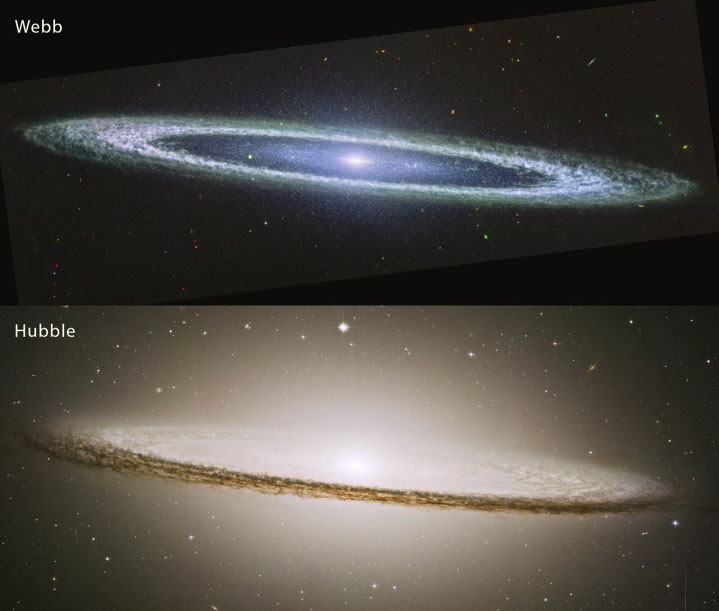Admire the stunning view of the Sombrero Galaxy through the eyes of the James Webb Space Telescope
A new image from the James Webb Space Telescope reveals a beautiful and majestic sight: the Sombrero Galaxy (also known as Messier 104), named for its resemblance to a traditional Mexican hat. With a wide, flat shape reminiscent of the famous wide brim of the hat, the galaxy has beautiful outer rings that are clearly visible.
The Sombrero Galaxy is located 30 million light-years away in the constellation Virgo, and was previously photographed by the Hubble Space Telescope. However, in the Hubble image, the galaxy appears as a pale, opaque disk. In the new image from the James Webb Space Telescope, you can see a blue outer disk, with a small bright core at the center that defines the galaxy. Everything appears in sharp detail.
 Admire the stunning view of the Sombrero Galaxy through the eyes of the James Webb Space Telescope Picture 1
Admire the stunning view of the Sombrero Galaxy through the eyes of the James Webb Space Telescope Picture 1
The difference between the two images is largely due to the different wavelengths at which the telescopes operate. Hubble takes images primarily in the visible light portion of the spectrum, the same wavelengths our eyes can see. As a result, dusty galaxies like the Sombrero appear opaque. James Webb, on the other hand, operates in the infrared portion of the spectrum, meaning it can peer through the dust to see structures invisible to the human eye.
The James Webb image also shows more detail of the dust that makes up the outer reaches of the galaxy's rings. If you look closely, you can see that this blue-white shape is clumpy, with the dust unevenly distributed in pockets that are denser in some places than others. The region is interesting to scientists because it contains molecules called polycyclic aromatic hydrocarbons, which are often found in regions where young stars are forming. But the rate of star formation in this galaxy is quite low, with the Sombrero rings producing half as many stars per year as our own galaxy, the Milky Way.
Another feature of this image is the bright light at the center of the galaxy, a region around the galaxy's supermassive black hole, known as the active galactic nucleus (AGN). This region is not as bright as some other AGNs, because the central black hole is relatively quiet, not devouring large amounts of matter as seen in some other galaxies.
You should read it
- Admire the beautiful 'penguin' against the backdrop of space through the eyes of the James Webb telescope
- NASA successfully launched the James Webb space telescope, a 'time machine' that gives us a look into the past of the Universe
- Admire the 'very different' image of Saturn under the eyes of the Hubble telescope
- Admire the majestic spectacle of swirls of dust and gas in nearby galaxies
- Admire the magical beauty of the Rho Ophiuchi star system through the eyes of the James Webb . telescope
- The Most Powerful Space Telescope Ever Built Will Look Back In Time To The Dark Ages Of The Universe
- Ancient 'spider web galaxy' cluster discovered, 10 billion years old
- Admire the colorful moment of a star in the making
- This exoplanet is half day and is nearly 800 degrees Celsius hot
- Admire stunning images showing the strange phenomenon of the Serpens Nebula
- World's most expensive space telescope captures the moment two galaxies are about to collide
- James Webb captured the most difficult to find object in the universe, 2,000 light years away






 Admire the beautiful 'penguin' against the backdrop of space through the eyes of the James Webb telescope
Admire the beautiful 'penguin' against the backdrop of space through the eyes of the James Webb telescope Admire the 'very different' image of Saturn under the eyes of the Hubble telescope
Admire the 'very different' image of Saturn under the eyes of the Hubble telescope Admire the magical beauty of the Rho Ophiuchi star system through the eyes of the James Webb . telescope
Admire the magical beauty of the Rho Ophiuchi star system through the eyes of the James Webb . telescope Admire the colorful moment of a star in the making
Admire the colorful moment of a star in the making NASA successfully launched the James Webb space telescope, a 'time machine' that gives us a look into the past of the Universe
NASA successfully launched the James Webb space telescope, a 'time machine' that gives us a look into the past of the Universe Admire stunning images showing the strange phenomenon of the Serpens Nebula
Admire stunning images showing the strange phenomenon of the Serpens Nebula